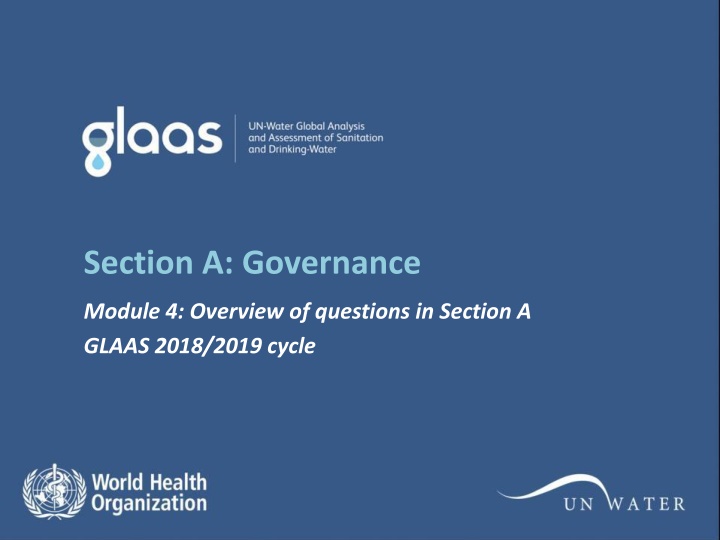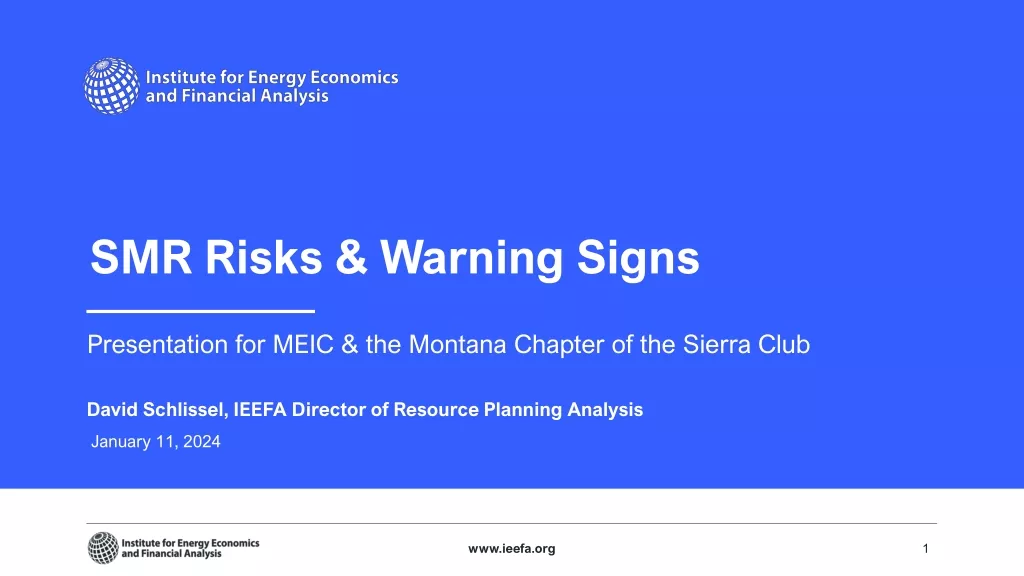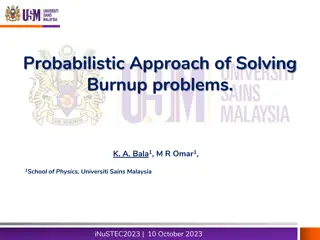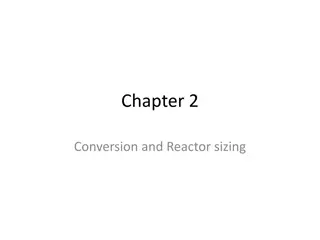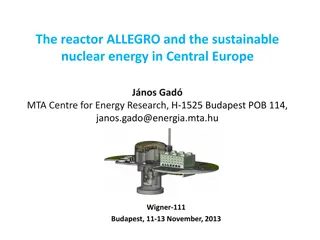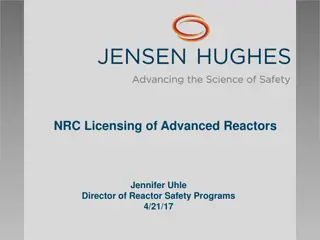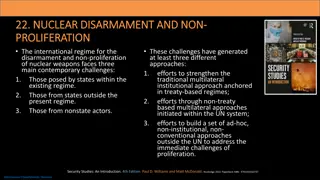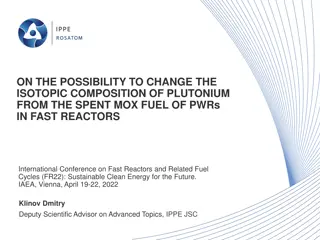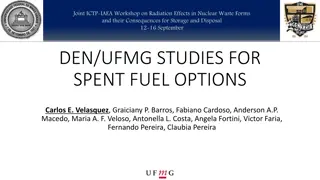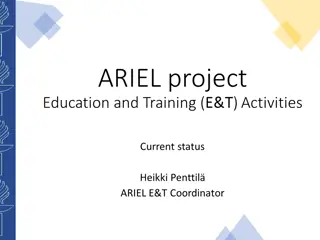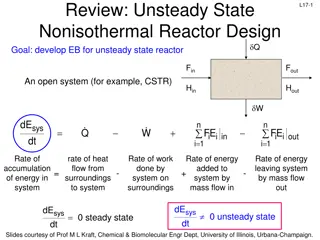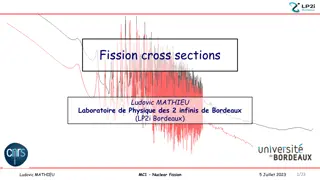Dynamic Probabilistic Risk Assessment in Nuclear Reactors
This research focuses on Dynamic Probabilistic Risk Assessment for Cyber Security Risk Analysis in Nuclear Reactors. It discusses the objectives of PRA, initiating events, elements of cyber-attack on ICS, and advantages of DPRA. The study aims to identify potential risks, consequences, and likelihood of occurrences in order to enhance reactor safety and cybersecurity measures.
Download Presentation

Please find below an Image/Link to download the presentation.
The content on the website is provided AS IS for your information and personal use only. It may not be sold, licensed, or shared on other websites without obtaining consent from the author.If you encounter any issues during the download, it is possible that the publisher has removed the file from their server.
You are allowed to download the files provided on this website for personal or commercial use, subject to the condition that they are used lawfully. All files are the property of their respective owners.
The content on the website is provided AS IS for your information and personal use only. It may not be sold, licensed, or shared on other websites without obtaining consent from the author.
E N D
Presentation Transcript
Section A: Governance Module 4: Overview of questions in Section A GLAAS 2018/2019 cycle
Why governance? Governance is the thematic focus for this cycle including: Policies and plans, which are critical foundations for sectoral planning National targets, which are strong indicators for progress and in-country accountability
Overview Section A consists of 14 questions covering governance, including polices, plans and targets. This module will go through each of the questions. Please also reference the survey guidance.
Questions A1: Human rights to water and sanitation A9: Vulnerable groups in national WASH policies and plans A10: Vulnerable groups in national WASH targets A11: Institutional roles and responsibilities and lead agencies A2: National development plans A3: National regulations and standards A4: Policy and plan development processes and effectiveness A12: Coordination between actors A5: National policies and plans A13: Coordinating with development partners A14: Community and user participation A6: National target-setting process A7: National targets A8: Progress on national targets
A14 A13 A1 A1 A2 A3 A4 A5 A6 A7 A8 A9 A10 A11 A12 Question A1 Human rights to water and sanitation This question aims to assess: If countries recognize the human rights to safe and clean drinking-water and sanitation through the constitution, legislation, laws or individual court cases.
A14 A13 A1 A1 A2 A3 A4 A5 A6 A7 A8 A9 A10 A11 A12 Answer A1.a and A1.b for each column Provide references for the constitution or legislation where human rights are recognized NOTE: In the fillable PDF survey form, you can scroll through the text entered into text boxes by using the arrow keys. If there is still not enough space, please use the survey annex form.
A14 A13 A1 A1 A2 A3 A4 A5 A6 A7 A8 A9 A10 A11 A12 In some countries, courts or individual court cases have recognized these rights in their decisions Describe the case(s) that recognized the human rights to water and sanitation. If more space is needed, please use the survey annex.
A14 A13 A1 A2 A2 A3 A4 A5 A6 A7 A8 A9 A10 A11 A12 Question A2 National development plans This question aims to assess: If national development plans exist The extent to which national development plans address drinking-water and sanitation
A14 A13 A1 A2 A2 A3 A4 A5 A6 A7 A8 A9 A10 A11 A12 These are social and/or economic development plans or strategies that outline overall development objectives for the country. They are often multi-year plans.
A14 A13 A1 A2 A2 A3 A4 A5 A6 A7 A8 A9 A10 A11 A12 Describe how drinking-water is addressed. Describe how sanitation is addressed.
A14 A13 A1 A2 A3 A3 A4 A5 A6 A7 A8 A9 A10 A11 A12 Question A3 National regulations and standards This question aims to assess: The types of standards and regulations for urban and rural drinking-water, sanitation, and wastewater that exist The use of risk management approaches
A14 A13 A1 A2 A3 A3 A4 A5 A6 A7 A8 A9 A10 A11 A12 Question A3 National regulations and standards Please note the distinction between regulations and standards: Standard: The term standard is commonly used to describe a mandatory numerical value in a table of parameters and limits (such as 10 g/L of arsenic). However, it is also used to describe technical standards and policy documents designed to help achieve improved water quality. Regulations (or regulatory instruments): Rules created by an administrative agency or body that typically include tangible measures that are necessary to implement and/or enforce the general requirements prescribed in the broader legislation. Regulations may cover water quality standards, service-level / service delivery standards, required monitoring frequencies requirements for risk management, surveillance requirements and/or audit guidance, etc.
A14 A13 A1 A2 A3 A3 A4 A5 A6 A7 A8 A9 A10 A11 A12 If your country has the same standards and/or regulations for both urban and rural, please respond in both columns, answering the same for both.
A14 A13 A1 A2 A3 A3 A4 A5 A6 A7 A8 A9 A10 A11 A12 These questions ask for information on the drinking-water quality and drinking-water service delivery standards and/or regulations e.g. standards and/or regulations on continuity of service, equity or accessibility of services, affordability of services.
A14 A13 A1 A2 A3 A3 A4 A5 A6 A7 A8 A9 A10 A11 A12 These questions ask for information on the sanitation and wastewater standards and/or regulations These questions ask for information on the required or promoted use of water safety planning or sanitation safety planning or equivalent approaches
A14 A13 A1 A2 A3 A3 A4 A5 A6 A7 A8 A9 A10 A11 A12 Please see the definitions for these risk management approaches in the survey guidance.
A14 A13 A1 A2 A3 A4 A4 A5 A6 A7 A8 A9 A10 A11 A12 Question A4 Policy and plan development processes and effectiveness This question introduces a set of questions aimed at capturing information on national policies and plans for WASH, which are distinguished as follows: Policies: A policy is a key guiding instrument for present and future decisions. Policies are the principle guides to action taken by the government to achieve national, sector and/or industry-wide goals. Plans: A plan gives effect to decisions based on policy. Plans are implementable items that establish targets to achieve and provide details on implementing policy or regulation. Plans can assign responsibilities, and indicate how the responsible entities will respond to requirements set forth by policy, law and regulation, the type of training and development that will be provided, and how financial and human resources will be allocated.
A14 A13 A1 A2 A3 A4 A4 A5 A6 A7 A8 A9 A10 A11 A12 Question A4 Policy and plan development processes and effectiveness This question aims to assess: The process for developing national policies and plans for WASH The effectiveness of policy content
A14 A13 A1 A2 A3 A4 A4 A5 A6 A7 A8 A9 A10 A11 A12 These questions may require close consultation with relevant government/ministries and other interested parties to capture the process for developing national policies and plans for WASH If more space is needed to answer these questions, please use the survey annex.
A14 A13 A1 A2 A3 A4 A4 A5 A6 A7 A8 A9 A10 A11 A12 This question refers to the content of any national policy that covers the sub- sectors listed. You may want to return to this question and finalize the information after completing question A5.
A14 A13 A1 A2 A3 A4 A4 A5 A6 A7 A8 A9 A10 A11 A12 Mark this box if a national policy relating to the sub-sector does not exist. Indicate the extent to which policies have been effective. If more space is needed, please use the survey annex.
A14 A13 A1 A2 A3 A4 A5 A5 A6 A7 A8 A9 A10 A11 A12 Question A5 National policies and plans for drinking- water, sanitation, hygiene and institutional WASH This question aims to assess: The status of policies or plans in the following areas: Sanitation: urban (A5I) and rural (A5II) Drinking-water: urban (A5III) and rural (A5IV) Hygiene (A5V) WASH in health care facilities (A5VI.a) WASH in schools (A5VI.b) Infection prevention and control (A5VI.c) Health care waste management (A5VI.d) Other WASH (A5VII) The availability of resources to support plans The content and responsible ministries of the policies and plans
A14 A13 A1 A2 A3 A4 A5 A5 A6 A7 A8 A9 A10 A11 A12 Question A5I A5V follow the information presented on this slide for each of the sub-sectors: Sanitation: urban (A5I) and rural (A5II) Drinking-water: urban (A5III) and rural (A5IV) Hygiene (A5V) The sub-sector for which we are seeking information on policies and plans is indicated here.
A14 A13 A1 A2 A3 A4 A5 A5 A6 A7 A8 A9 A10 A11 A12 Question A5I A5V follow the instructions presented on this slide for each of the sub-sectors: Sanitation: urban (A5I) and rural (A5II) Drinking-water: urban (A5III) and rural (A5IV) Hygiene (A5V) If there is not a specific urban or rural policy or implementation plan, please answer for both urban and rural. The name of the combined policy or plan can be indicated in the space provided for the name of the policy or plan.
A14 A13 A1 A2 A3 A4 A5 A5 A6 A7 A8 A9 A10 A11 A12 Question A5I A5V follow the instructions presented on this slide for each of the sub-sectors: Sanitation: urban (A5I) and rural (A5II) Drinking-water: urban (A5III) and rural (A5IV) Hygiene (A5V) If a single policy or plan addresses more than one sub-sector, please respond to each of the questions for the WASH areas covered by the combined policy or plan.
A14 A13 A1 A2 A3 A4 A5 A5 A6 A7 A8 A9 A10 A11 A12 Question A5I A5V follow the structure presented on this slide for each of the sub-sectors: Sanitation: urban (A5I) and rural (A5II) Drinking-water: urban (A5III) and rural (A5IV) Hygiene (A5V) Part a. asks for the status of policies Part b. asks for the status of plans and availability of resources to support the plan Part c. asks if policies or plans address the elements listed and if so, which actor is responsible
A14 A13 A1 A2 A3 A4 A5 A5 A6 A7 A8 A9 A10 A11 A12 Question A5VI follows a more open structure to capture information on policies and plans that may cover aspects of: - WASH in health care facilities - WASH in schools - Infection prevention and control - Health care waste management
A14 A13 A1 A2 A3 A4 A5 A5 A6 A7 A8 A9 A10 A11 A12 A5VI may require consultation with ministries or departments working with education and health, including the environmental health focal point within the Ministry of Health.
A14 A13 A1 A2 A3 A4 A5 A5 A6 A7 A8 A9 A10 A11 A12 While some countries may have stand-alone policies and/or plans for WASH in health care facilities or WASH in schools, others may include measures in national WASH policies/plans or health or education policies/plans.
A14 A13 A1 A2 A3 A4 A5 A5 A6 A7 A8 A9 A10 A11 A12 Multiple columns are provided in case there is more than one policy and/or plan that addresses the sub- sector. If more space is needed please use the survey annex.
A14 A13 A1 A2 A3 A4 A5 A5 A6 A7 A8 A9 A10 A11 A12 A5VII seeks information on any policies or plans relating to the WASH sector that have not already been mentioned in A5. If more space is needed, please use the survey annex.
A14 A13 A1 A2 A3 A4 A5 A6 A6 A7 A8 A9 A10 A11 A12 Question A6 National target-setting process This question aims to assess: How national targets are established Which stakeholders and/or government agencies are involved in setting targets What considerations are taken into account when establishing targets
A14 A13 A1 A2 A3 A4 A5 A6 A6 A7 A8 A9 A10 A11 A12 For each sub-sector, which ministry or national institution establishes national targets.
A14 A13 A1 A2 A3 A4 A5 A6 A6 A7 A8 A9 A10 A11 A12 Please answer for each WASH area. If additional space is needed for clarification, please use the survey annex.
A14 A13 A1 A2 A3 A4 A5 A6 A7 A7 A8 A9 A10 A11 A12 Question A7 National targets This question aims to assess: What national targets have been established How national targets are defined What elements are included in the national targets
A14 A13 A1 A2 A3 A4 A5 A6 A7 A7 A8 A9 A10 A11 A12 Question A7I A7III follow the instructions presented on this slide for each of the sub-sectors: A7I: Sanitation - urban (a-c) and rural (d-f) A7II: Drinking-water - urban (a-c) and rural (d-f) A7III: Hygiene (a-c) The sub-sector for which we are seeking information on national targets is indicated here.
A14 A13 A1 A2 A3 A4 A5 A6 A7 A7 A8 A9 A10 A11 A12 Question A7I A7III follow the instructions presented on this slide for each of the sub-sectors: A7I: Sanitation - urban (a-c) and rural (d-f) A7II: Drinking-water - urban (a-c) and rural (d-f) A7III: Hygiene (a-c) If your country does not separate urban and rural targets, skip parts d-f and move onto the next sub-question in A7.
A14 A13 A1 A2 A3 A4 A5 A6 A7 A7 A8 A9 A10 A11 A12 Question A7I A7III follow the instructions presented on this slide for each of the sub-sectors: A7I: Sanitation - urban (a-c) and rural (d-f) A7II: Drinking-water - urban (a-c) and rural (d-f) A7III: Hygiene (a-c) Parts a./d. ask for the coverage target of the sub-sector. Please describe in as much detail as possible.
A14 A13 A1 A2 A3 A4 A5 A6 A7 A7 A8 A9 A10 A11 A12 Question A7I A7III follow the instructions presented on this slide for each of the sub-sectors: A7I: Sanitation - urban (a-c) and rural (d-f) A7II: Drinking-water - urban (a-c) and rural (d-f) A7III: Hygiene (a-c) Part b. and Part e. seek to understand the coverage target in relation to SDG criteria.
A14 A13 A1 A2 A3 A4 A5 A6 A7 A7 A8 A9 A10 A11 A12 Question A7I A7III follow the instructions presented on this slide for each of the sub-sectors: A7I: Sanitation - urban (a-c) and rural (d-f) A7II: Drinking-water - urban (a-c) and rural (d-f) A7III: Hygiene (a-c) NOTE: A7II asks for specific values or details for Part b. and Part e. For example, if service hours per day are included in the coverage target, please indicate the minimum number of service hours per day.
A14 A13 A1 A2 A3 A4 A5 A6 A7 A7 A8 A9 A10 A11 A12 Question A7I A7III follow the instructions presented on this slide for each of the sub-sectors: A7I: Sanitation - urban (a-c) and rural (d-f) A7II: Drinking-water - urban (a-c) and rural (d-f) A7III: Hygiene (a-c) This section asks for additional targets (i.e., not coverage) for the areas listed. Please describe the target measure in as much detail as possible.
A14 A13 A1 A2 A3 A4 A5 A6 A7 A7 A8 A9 A10 A11 A12 Question A7I A7III follow the instructions presented on this slide for each of the sub-sectors: A7I: Sanitation - urban (a-c) and rural (d-f) A7II: Drinking-water - urban (a-c) and rural (d-f) A7III: Hygiene (a-c) Any additional targets under the sub-sector can be listed here. If more space is needed, please use the survey annex.
A14 A13 A1 A2 A3 A4 A5 A6 A7 A7 A8 A9 A10 A11 A12 A7IV asks for information on national targets established for WASH in health care facilities and WASH in schools. If your country has national targets for institutional WASH, please describe these in as much detail as possible for each sub-sector.
A14 A13 A1 A2 A3 A4 A5 A6 A7 A7 A8 A9 A10 A11 A12 Any additional targets under the sub-sector can be listed here. If more space is needed, please use the survey annex.
A14 A13 A1 A2 A3 A4 A5 A6 A7 A8 A8 A9 A10 A11 A12 Question A8 Progress on national targets This question aims to assess: Progress towards national WASH targets
A14 A13 A1 A2 A3 A4 A5 A6 A7 A8 A8 A9 A10 A11 A12 Question A8 is based on the targets identified in A7. If a target was not applicable to your country, please leave the row blank. This column lists the targets, including coverage target, for each sub-sector. If you indicated combined urban and rural coverage targets, then only fill in A8.a and A8.c and SKIP A8.b and A8.d.
A14 A13 A1 A2 A3 A4 A5 A6 A7 A8 A8 A9 A10 A11 A12 A8 continues in the same manner on the next page of the survey.
A14 A13 A1 A2 A3 A4 A5 A6 A7 A8 A8 A9 A10 A11 A12 Indicate the baseline value that was measured and when the measurement was taken. Indicate the most recent value that was measured and when the measurement was taken.
A14 A13 A1 A2 A3 A4 A5 A6 A7 A8 A8 A9 A10 A11 A12 Indicate the source of the data for target monitoring. Publicly available means that information that has been published or broadcast for public consumption and may be obtained through government offices or is available online.
A14 A13 A1 A2 A3 A4 A5 A6 A7 A8 A9 A9 A10 A11 A12 Question A9 Vulnerable groups in national policies and plans This question aims to assess: If measures are identified in policies or plans to reach vulnerable groups with WASH services The level of implementation of these measures This section introduces a set of questions on equity measures to extend WASH services to vulnerable populations
